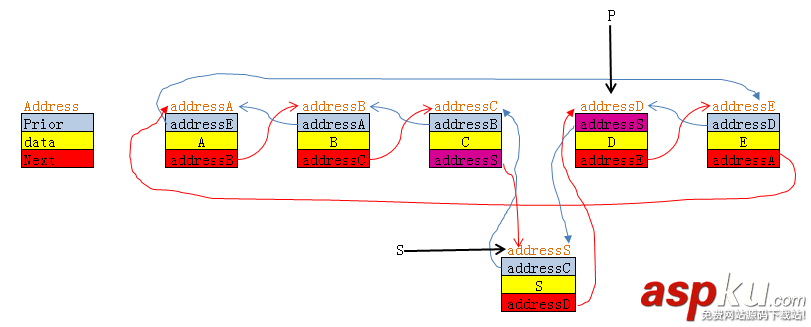1.概念
雙向鏈表也叫雙鏈表,是鏈表的一種,它的每個數據結點中都有兩個指針,分別指向直接后繼和直接前驅。所以,從雙向鏈表中的任意一個結點開始,都可以很方便地訪問它的前驅結點和后繼結點。一般我們都構造雙向循環鏈表。
結構圖如下所示:


2.基本操作實例
DoubleList.cpp
#include "stdafx.h"#include "DoubleList.h"#include <stdio.h>#include <malloc.h>#include <stdlib.h>DoubleList::DoubleList(){ pDoubleListNode pDouList = NULL; // 創建雙鏈表 CreateDouList(pDouList); PrintDouList(pDouList); // 打印逆序鏈表 PrintDouReverseList(pDouList); // 節點后插入節點 InsertNodeAfter(pDouList); PrintDouList(pDouList); // 節點前插入節點 InsertNodeBefore(pDouList); PrintDouList(pDouList); // 刪除節點 DeleteNode(pDouList); PrintDouList(pDouList); // 刪除鏈表 DeleteDouList(pDouList); PrintDouList(pDouList); system("PAUSE");}DoubleList::~DoubleList(){}//創建雙向鏈表void DoubleList::CreateDouList(pDoubleListNode &head){ char x; // 定義成char型是用于輸入'q'時可以退出,其實定義成int也能退出 pDoubleListNode p, s; head = (pDoubleListNode)malloc(sizeof(DoubleListNode)); head->next = NULL; head->prior = NULL; // 構造頭結點p p = head; printf("/n輸入雙向鏈表的元素,每輸入一個元素后按回車,輸入q表示結束./n"); fflush(stdin); //清空輸入緩沖區 x = getchar(); while (x != 'q') { s = (pDoubleListNode)malloc(sizeof(DoubleListNode)); s->data = x - '0'; // 得到的是輸入字符的ASCII碼,減去30H就變成想要的數字 s->next = NULL; s->prior = p; p->next = s; p = s; fflush(stdin); x = getchar(); } if (x == 'q') { printf("雙向鏈表構造完畢!/n"); }}//打印雙向鏈表void DoubleList::PrintDouList(pDoubleListNode &head){ pDoubleListNode p; printf("/n打印出雙向鏈表數據為:/n"); if (!IsDouListEmpty(head)) { p = head->next; while (p) { printf("%d/n", p->data); p = p->next; } }}//逆序打印雙向鏈表void DoubleList::PrintDouReverseList(pDoubleListNode &head){ pDoubleListNode p; printf("/n打印出逆序雙向鏈表數據為:/n"); if (!IsDouListEmpty(head)) { p = head->next; while (p->next) { p = p->next; } while (p->prior) { printf("%d /n", p->data); p = p->prior; } }}//求鏈表長度int DoubleList::GetDouListLength(pDoubleListNode &head){ int length = 0; if (head == NULL) { printf("鏈表不存在,請先初始化!/n"); } else { pDoubleListNode p = head->next; while (p) { length++; p = p->next; } } return length;}//判斷鏈表是否為空bool DoubleList::IsDouListEmpty(pDoubleListNode &head){ if (head == NULL) { printf("鏈表不存在,請先初始化!/n"); return true; } else if (head->next == NULL) { printf("鏈表為空!/n"); return true; } return false;}//把雙向鏈表置空void DoubleList::ClearDouList(pDoubleListNode &head){ if (head == NULL) { printf("鏈表不存在,請先初始化!/n"); } else { pDoubleListNode p, q; p = q = head->next; //是p、q指向第一個元素 head->next = NULL; while (p) //逐個釋放元素所占內存 { p = p->next; free(q); q = p; } }}// 刪除雙向鏈表void DoubleList::DeleteDouList(pDoubleListNode &head){ printf("/n刪除雙向鏈表/n"); ClearDouList(head); free(head); head = NULL;}// 在雙向鏈表中第i個位置后面插入元素void DoubleList::InsertNodeAfter(pDoubleListNode &head){ int data, pos; pDoubleListNode p, s; p = head; int i = 0; printf("/n在雙向鏈表中第i個位置后面插入元素/n"); printf("請輸入要插入的元素和位置:/n"); scanf_s("%d%d", &data, &pos, 100); if (head == NULL) { printf("鏈表不存在,請先初始化!/n"); } else if (head->next == NULL) { printf("鏈表為空,插入第一個元素!/n"); s = (pDoubleListNode)malloc(sizeof(DoubleListNode)); s->data = data; s->prior = NULL; s->next = NULL; head->next = s; // 將新結點插入head后 } else if (pos<1 || pos>GetDouListLength(head) + 1) { printf("插入位置錯誤!/n"); } else { while (i < pos) { p = p->next; i++; } if (i == GetDouListLength(head)) //如果在最后一個元素后面插入data { s = (pDoubleListNode)malloc(sizeof(DoubleListNode)); s->data = data; s->next = NULL; s->prior = p; p->next = s; } else { s = (pDoubleListNode)malloc(sizeof(DoubleListNode)); s->data = data; s->next = p->next; p->next->prior = s; p->next = s; s->prior = p; } }}// 在雙向鏈表中第i個位置前面插入元素void DoubleList::InsertNodeBefore(pDoubleListNode &head){ int data, pos; pDoubleListNode p, s; p = head; int i = 0; printf("/n在雙向鏈表中第i個位置前面插入元素/n"); printf("請輸入要插入的元素和位置:/n"); scanf_s("%d%d", &data, &pos, 100); if (head == NULL) { printf("鏈表不存在,請先初始化!/n"); } else if (head->next == NULL) { printf("鏈表為空,插入第一個元素!/n"); s = (pDoubleListNode)malloc(sizeof(DoubleListNode)); s->data = data; s->prior = NULL; s->next = NULL; head->next = s; // 將新結點插入head后 } else if (pos<1 || pos>GetDouListLength(head) + 1) { printf("插入位置錯誤!/n"); } else { while (i < pos) { p = p->next; i++; } if (i == 1) // 如果在第一個元素前面插入data { s = (pDoubleListNode)malloc(sizeof(DoubleListNode)); s->data = data; head->next = s; // 將新結點插入head后 s->prior = head; // 新結點的前結點指向頭結點 s->next = p; // 新結點的后結點指向原head的后結點 p->prior = s ; // 原第一個結點的前結點指向新結點 } else { s = (pDoubleListNode)malloc(sizeof(DoubleListNode)); s->data = data; s->prior = p->prior; s->next = p; p->prior->next = s; p->prior = s; } }}//刪除雙向鏈表中的第i個元素void DoubleList::DeleteNode(pDoubleListNode &head){ int pos; int i = 0; pDoubleListNode p = head; printf("/n在雙向鏈表中刪除第i個位置的元素/n"); printf("請輸入要刪除的位置:"); scanf_s("%d", &pos, 100); if (IsDouListEmpty(head)) { return; } else if (pos<1 || pos>GetDouListLength(head)) { printf("刪除的位置不存在!/n"); } else { while (i < pos) { p = p->next; i++; } if (i == GetDouListLength(head)) { p->prior->next = NULL; free(p); } else { p->prior->next = p->next; p->next->prior = p->prior; free(p); } }}DoubleList.h
#pragma oncetypedef struct DoubleListNode{ int data; //數據 struct DoubleListNode *prior; //前驅 struct DoubleListNode *next; //后繼}DoubleListNode, *pDoubleListNode;class DoubleList{public: DoubleList(); ~DoubleList(); //初始化雙向鏈表 void DoubleList::CreateDouList(pDoubleListNode &head); //打印雙向鏈表 void DoubleList::PrintDouList(pDoubleListNode &head); //逆序打印雙向鏈表 void DoubleList::PrintDouReverseList(pDoubleListNode &head); //求鏈表長度 int DoubleList::GetDouListLength(pDoubleListNode &head); //判斷鏈表是否為空 bool DoubleList::IsDouListEmpty(pDoubleListNode &head); //把雙向鏈表置空 void DoubleList::ClearDouList(pDoubleListNode &head); //刪除雙向鏈表 void DoubleList::DeleteDouList(pDoubleListNode &head); //在雙向鏈表中第i個位置后面插入元素m void DoubleList::InsertNodeAfter(pDoubleListNode &head); // 在雙向鏈表中第i個位置前面插入元素 void DoubleList::InsertNodeBefore(pDoubleListNode &head); //刪除雙向鏈表中的第i個元素 void DoubleList::DeleteNode(pDoubleListNode &head);};3.對鏈表插入節點的理解
例如在節點i前插入一個新的節點(即上面代碼中的InsertNodeBefore函數):
typedef struct DoubleListNode{ int data; // 數據 struct DoubleListNode *prior; // 前驅 struct DoubleListNode *next; // 后繼}DoubleListNode, *pDoubleListNode;假設該鏈表由五個節點構成,分別為A,B,C,D,E

圖中假設了A,B,C,D,E的地址分別為:addressA,addressB,addressC,addressD,addressE。
下面將分析鏈表的前插的例子:
雙鏈表的前插,下面這是在節點"D"前插入一個新的節點"S"的代碼和分析

以上這篇C++ 雙鏈表的基本操作(詳解)就是小編分享給大家的全部內容了,希望能給大家一個參考,也希望大家多多支持VEVB武林網。
新聞熱點
疑難解答